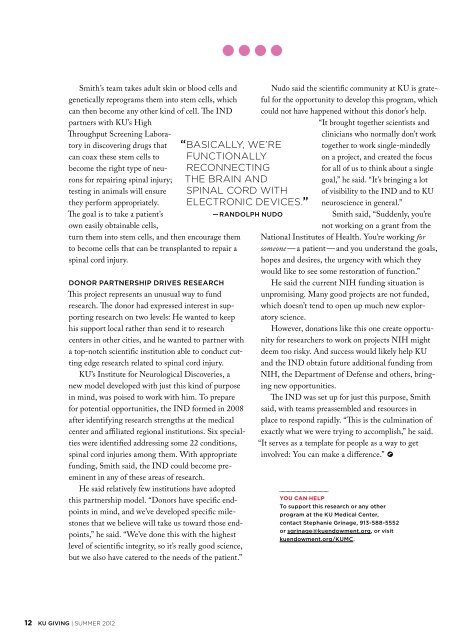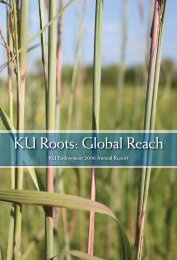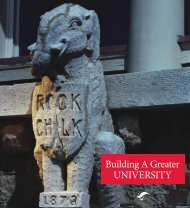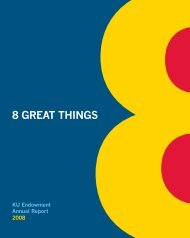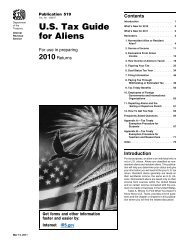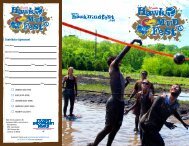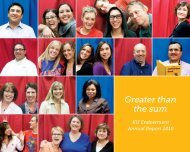download a PDF version - KU Endowment
download a PDF version - KU Endowment
download a PDF version - KU Endowment
You also want an ePaper? Increase the reach of your titles
YUMPU automatically turns print PDFs into web optimized ePapers that Google loves.
Smith’s team takes adult skin or blood cells and<br />
genetically reprograms them into stem cells, which<br />
can then become any other kind of cell. The IND<br />
partners with <strong>KU</strong>’s High<br />
Throughput Screening Laboratory<br />
in discovering drugs that<br />
can coax these stem cells to<br />
become the right type of neurons<br />
for repairing spinal injury;<br />
testing in animals will ensure<br />
they perform appropriately.<br />
The goal is to take a patient’s<br />
own easily obtainable cells,<br />
turn them into stem cells, and then encourage them<br />
to become cells that can be transplanted to repair a<br />
spinal cord injury.<br />
“Basically, we’re<br />
functionally<br />
reconnecting<br />
the brain and<br />
spinal cord with<br />
electronic devices.”<br />
Donor partnership drives research<br />
This project represents an unusual way to fund<br />
research. The donor had expressed interest in supporting<br />
research on two levels: He wanted to keep<br />
his support local rather than send it to research<br />
centers in other cities, and he wanted to partner with<br />
a top-notch scientific institution able to conduct cutting<br />
edge research related to spinal cord injury.<br />
<strong>KU</strong>’s Institute for Neurological Discoveries, a<br />
new model developed with just this kind of purpose<br />
in mind, was poised to work with him. To prepare<br />
for potential opportunities, the IND formed in 2008<br />
after identifying research strengths at the medical<br />
center and affiliated regional institutions. Six specialties<br />
were identified addressing some 22 conditions,<br />
spinal cord injuries among them. With appropriate<br />
funding, Smith said, the IND could become preeminent<br />
in any of these areas of research.<br />
He said relatively few institutions have adopted<br />
this partnership model. “Donors have specific endpoints<br />
in mind, and we’ve developed specific milestones<br />
that we believe will take us toward those endpoints,”<br />
he said. “We’ve done this with the highest<br />
level of scientific integrity, so it’s really good science,<br />
but we also have catered to the needs of the patient.”<br />
— Randolph Nudo<br />
Nudo said the scientific community at <strong>KU</strong> is grateful<br />
for the opportunity to develop this program, which<br />
could not have happened without this donor’s help.<br />
“It brought together scientists and<br />
clinicians who normally don’t work<br />
together to work single-mindedly<br />
on a project, and created the focus<br />
for all of us to think about a single<br />
goal,” he said. “It’s bringing a lot<br />
of visibility to the IND and to <strong>KU</strong><br />
neuroscience in general.”<br />
Smith said, “Suddenly, you’re<br />
not working on a grant from the<br />
National Institutes of Health. You’re working for<br />
someone — a patient — and you understand the goals,<br />
hopes and desires, the urgency with which they<br />
would like to see some restoration of function.”<br />
He said the current NIH funding situation is<br />
unpromising. Many good projects are not funded,<br />
which doesn’t tend to open up much new exploratory<br />
science.<br />
However, donations like this one create opportunity<br />
for researchers to work on projects NIH might<br />
deem too risky. And success would likely help <strong>KU</strong><br />
and the IND obtain future additional funding from<br />
NIH, the Department of Defense and others, bringing<br />
new opportunities.<br />
The IND was set up for just this purpose, Smith<br />
said, with teams preassembled and resources in<br />
place to respond rapidly. “This is the culmination of<br />
exactly what we were trying to accomplish,” he said.<br />
“It serves as a template for people as a way to get<br />
involved: You can make a difference.”<br />
YOU CAN HELP<br />
To support this research or any other<br />
program at the <strong>KU</strong> Medical Center,<br />
contact Stephanie Grinage, 913-588-5552<br />
or sgrinage@kuendowment.org, or visit<br />
kuendowment.org/<strong>KU</strong>MC.<br />
12 <strong>KU</strong> GIVING | SUMMER 2012


